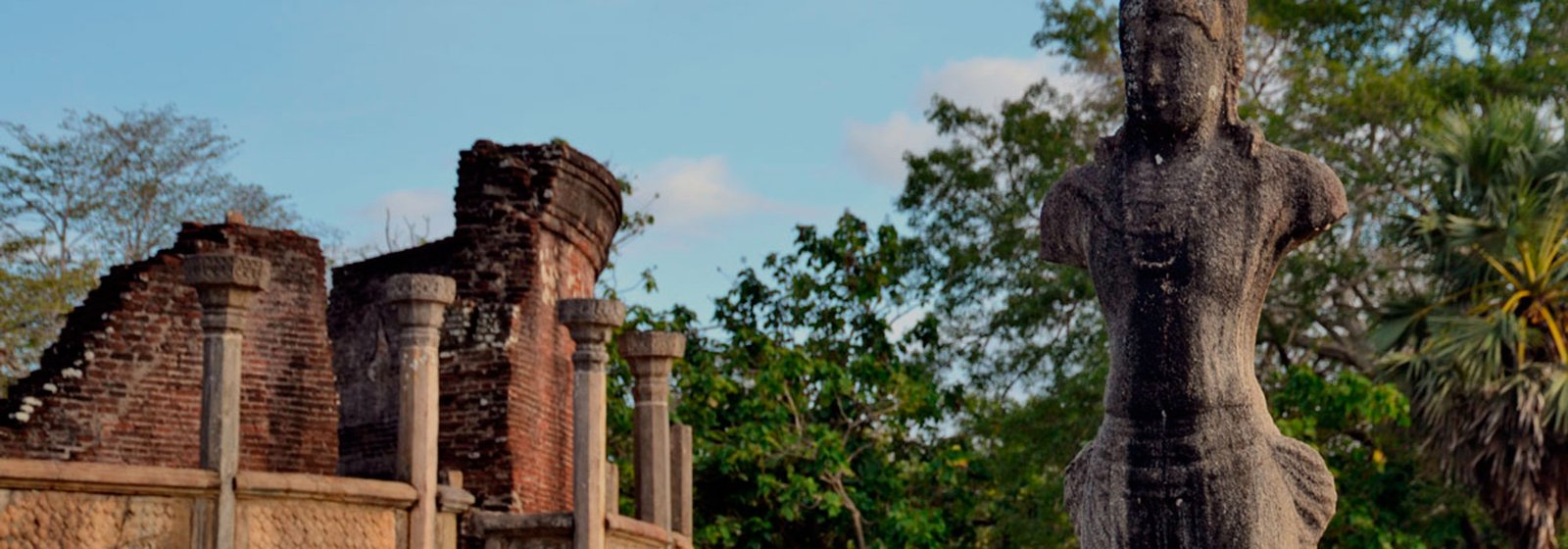The second most ancient of Sri Lanka’s kingdoms, Polonnaruwa served as the island’s capital from the 11th to 13th centuries, a relatively brief but glorious epoch that witnessed a flowering of Buddhist arts and architecture.
Polonnaruwa was established as the capital after Anuradhapura had been invaded in the late 10th century. Under King Parakramabu, who ruled in the late 11th century, Polonnaruwa became a magnificent walled city. He built the vast reservoir and ordered the construction of monasteries, temples, palaces, bathing pools and Buddhist statues, all set in a forested park surrounded by moats.
The Ancient City of Polonnaruwa has been declared a World Heritage Site.
Don't Miss
- Polonnaruwa Museum
- The Vatadage
- Lankatilaka Image House
- Gal Vihara
Sights in Polonnaruwa

VATADAGE
The Polonnaruwa Vatadage is an ancient structure believed to have been built during the reign of Parakramabahu I to hold the tooth relic of the Buddha, or during the reign of Nissanka Malla to hold the alms bowl used by the Buddha. Both these venerated relics would have given the structure a great significance and importance at the time. It is the best-preserved example of a Vatadage in the country and has been described as the ``ultimate development`` of this type of architecture. Abandoned for several centuries, excavation work at the Polonnaruwa Vatadage began in 1903.

RANKOTH VEHERA
Rankoth Vehera is a stupa built by Nissanka Malla, who ruled the country from 1187 to 1196. The Rankoth Vehera has been built according to the tradition of the stupas of Mahavihara of the Anuradhapura period and bears a close resemblance to the Ruwanweli Seya stupa. In fact, a stone inscription situated close to the stupa even identifies it by the name 'Ruwanweli'. However, it has later come to be known by the currently used name, Rankoth Vehera.

LANKATHILAKA IMAGE HOUSE
Polonnaruwa Lankathilaka Image House is a monolithic Buddha image house built by King Parakramabahu (1153-1186). The building is completely made out of bricks and the outer walls are covered with elaborate designs and carvings. The Buddha statue inside is completely made out of clay bricks and it has been 41 feet in height. Specially made flat bricks have been used to build this statue and today the portion above the shoulder is destroyed.

GAL VIHARA
The Gal Vihara is a rock temple of the Buddha was fashioned in the 12th century by Parakramabahu I. The central feature of the temple is four images of the Buddha, which have been carved into the face of a large granite rock. The images consist of a large seated figure, another smaller seated figure inside an artificial cavern, a standing figure and a reclining figure. These are considered to be some of the best examples of ancient Sinhalese sculpting and carving arts.

PALACE COMPLEX OF KING PARAKRAMABAHU
This is a majestic palace built by King Parakramabahu I (1153-1186) with seven stories and said to have 1000 chambers. Today you can see the massive walls over a meter thick going up to about 30 feet (9 meters) and the bottom half of the main stairway which led to upper floors. Inside the building, you can see parts of melted brick walls caused by intense heat when this was set fire by Tamil invaders at the end of the Polonnaruwa era. Around the main palace, there are remains of more buildings where the ministers, soldiers and servants lived.

NISSANKA LATHA MANDAPAYA
Nissanka Latha Mandapaya is a unique structure built by King Nissanka Malla (1187 1196) and is located near the western entrance of the Dalada Maluva, the area that contains the oldest and most sacred monuments in the city. The most important feature of this building is the shape and the carvings of the stone pillars. These pillars are carved in the shape of a lotus stork and are curved in three places. The top of the pillars takes the form of a lotus flower. On the centre is a small Stupa. The whole building is surrounded by a fence made out of stone.

THUPARAMA IMAGE HOUSE
The Thuparama Image House is one of the few buildings where you can see a roof completely made out of bricks. Almost the whole building has survived over 900 years. There was once a seating Buddha statue in the middle of the house which was made out of bricks, but it’s no longer there due to treasure hunters or south Indian invaders. But you can see a few other Buddha statues, which are all made out of limestone.

HATADAGE
Hatadage is an ancient relic shrine built by Nissanka Malla and had been used to keep the Relic of the tooth of the Buddha. The Hatadage had been built using stone, brick and wood, although only parts of the brick and stone walls now remain. It appears to have been a two-storey structure, but the upper storey has now been destroyed. Three Buddha statues carved out of granite rock are located within a chamber of the shrine.

ATADAGE
Tooth Relic Chamber of the 11th Century built by King Vijayabahu I (1070-1110). The name Atadage means ``House of Eight Relics``. This building was built on 54 stone pillars and the tooth relic was kept on the second floor. The access to the second floor is through a granite staircase, only a few steps remain today. There were three Buddha statues at the bottom and only the centre one remains today.




